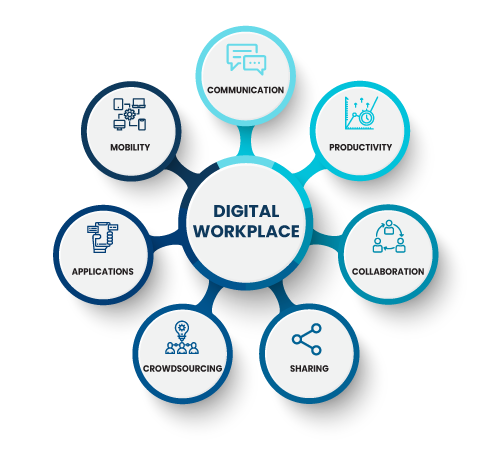
Today, we shall discuss a concept combining two of the most used words in recent times – digital and workplace.
That’s right; this article is dedicated to the digital workplace, which is currently the need of the hour.
What is a Digital Workplace?
Digital Workplace Definition:
The digital workplace uses digital transformation at work to improve the productivity and efficiency of business operations by aligning technology, employees, and business processes. It involves the modernization of traditional business processes, workflows, and collaboration through the adoption of digital technology.
A digital workplace, simply defined, is a virtual workplace setting. It is equivalent to the physical space, except it is virtual.
Just like a physical office, a virtual workplace plays a major role in engaging employees, ensuring efficiency, and maintaining a great culture. This is why it needs to be managed and taken care of properly. Let’s expand this further –
The key factors in a digital workplace are:
- People: People come first here. Their productivity and satisfaction are paramount; thus, they get the front seat.
- Technology: Digital workplace is 100% technology-driven. Thanks to the increased demand, advancements are making it easier to work virtually.
- Management: Coordination between people and technology is very important. This is only possible when the management and culture are strong and helpful. So, management occupies a big spot in the heart of the digital workplace.
Also read: 7 Workplace Health and Safety Apps Redefining OHS in Times of the Pandemic
Why does one need a Digital Workplace?
According to the annual State of the Digital Workplace Report, 72% regard digital workplace as “extremely important or very important.” The Digital Workplace is the cornerstone for modern organizations, fostering collaboration, productivity, and agility. One compelling reason for adopting a digital workplace is the ability to break down geographical barriers. With remote work becoming the norm, a digital workplace enables employees to connect, communicate, and collaborate seamlessly from anywhere in the world, expanding your talent pool and ensuring business continuity.
Moreover, a digital workplace streamlines processes and boosts efficiency. It centralizes information, making it easily accessible, and automates routine tasks, freeing time for employees to focus on more strategic activities. This enhances productivity and allows for better decision-making by providing real-time insights. Also, a well-implemented digital workplace can enhance employee satisfaction and retention, empowering individuals with the tools they need to work efficiently and flexibly. A digital workplace is crucial for organizations looking to thrive in today’s digital era, offering a competitive edge through improved collaboration, efficiency, and employee satisfaction.
One in five departments is struggling to adapt to the rapid changes in technology.
Advantages Of Building a Digital Workplace
Creating a digital workplace is a crucial step in modern business, but it’s not a one-time endeavour. To optimize your operations, you need a comprehensive strategy that allows for continuous improvement. Here’s how you can enhance your digital workplace:
Alignment with Your Vision
As your company evolves, so should your digital workplace. Regularly audit your software to ensure it aligns with your current needs and goals. Don’t hesitate to explore new providers or adjust your plans if existing tools no longer meet your requirements.
Scalability for Growth
A successful digital workplace should accommodate your company’s expansion. Choose software that can handle increased users, broader functionalities, and global operations. Consider the potential for integrating additional digital applications as your business grows.
User-Friendliness
A poorly designed, unintuitive digital workplace can frustrate employees and waste valuable time. Prioritize ease of use by ensuring all features are accessible and intuitive. Conduct regular audits to identify and address any usability issues.
Seamless Workflow
Your digital workplace should facilitate smooth workflows. Ensure that links, pages, and core functions are logically connected. For example, accounting teams might benefit from direct links to HR details for payroll purposes, while sales staff could use links to live inventory.
Employee Feedback
Your employees are the best source of insights into your digital workplace. Encourage their feedback on what works well, what’s missing, and how to improve processes. Their input can help you optimize communication apps and overall workflow.
Adaptive Learning Systems
As your software evolves, so should employee training. Provide easily accessible training materials, such as videos and walkthroughs, to empower employees to learn at their own pace and refer to resources as needed.
Remote Work Enablement
A well-designed digital workplace empowers employees to work effectively remotely. Cloud-based systems, shared updates, and collaboration tools facilitate seamless remote work. This can lead to increased productivity, cost savings, and greater agility.
Building a Connected Workplace
Foster a connected workplace by encouraging communication, collaboration, and social interactions. Peer mentorship, virtual events, and collaborative tools can help employees feel connected and engaged, regardless of their location.
By implementing these strategies, you can create a digital workplace that supports your company’s growth, enhances employee productivity, and drives overall success.
The Key Elements for a Digital Workplace Solution
The digital toolkit consists of all the technologies and tools you will need to build a successful digital workplace. While every business needs a few common tools, the final list will completely depend on your industry and your specific requirements. We are going to speak about the top 7 categories of tools that almost all organizations will need.

1. Communication
Messaging is the first tool because collaboration heavily depends on it in the digital workplace. Email, IM, mobile messaging, and microblogging are the most popular forms of communication. Examples include Microsoft Teams, Slack, etc.
2. Productivity
The popular tools that help employees work efficiently are word processors, presentation software, spreadsheets, task management tools, etc. Examples include Google Docs, Office 365, Trello, etc.
3. Collaboration
From Web Conferencing using Zoom or Microsoft Teams, multiple software programs are enabling clear collaboration between partners, clients, and employees.
4. Sharing
Here, we are specifically speaking about sharing information. Blogs, an intranet, and a personalized homepage are the popular tools used.
5. Crowdsourcing
Everything from forums to surveys, polls, and ideation platforms come under crowdsourcing tools.
6. Applications
CRM is one of the most pivotal applications that companies need. Besides that, there are ERP systems, HR systems, expense claims, etc., that empower employees to access multiple applications online without depending on one person or department. These may be web-based COTS applications or custom-built using low-code, no-code platforms.
7. Mobility
The digital workplace requires easy access to tools from various devices. So, remote scanners, laptops, smartphones, etc., are mandatory.
Driven by surging tech adoption, the Digital workplace market is expected to skyrocket from $33 billion in 2022 to a staggering $234 billion by 2032.
The Digital Workplace Framework Checklist
Assess the Current State
Begin by evaluating your organization’s existing technical infrastructure, the digital skills of your workforce, and overall readiness to embrace change. This foundational assessment helps identify gaps and opportunities, ensuring your digital workplace strategy is realistic and aligned with current capabilities.
Stakeholders & Buy-In
Identify a senior sponsor to champion the initiative and map out key stakeholders across all relevant functions. Involve those responsible for current tools and services to ensure alignment and gather diverse perspectives, which is essential for successful adoption.
Design a Digital Workplace Roadmap
Develop a strategic roadmap that outlines clear, achievable goals aligned with business priorities. Set fixed timelines, define measurable KPIs, and anticipate potential obstacles with mitigation plans to keep the project on track and transparent.
Governance
Establish clear ownership and governance frameworks to manage information lifecycle and ensure compliance with policies and regulations. Strong governance is crucial for maintaining control and maximizing the digital workplace’s long-term value.
Build Your Toolbox
Select and implement the right digital tools and technologies that empower employees to perform their roles effectively. Tailor the toolbox to your organization’s unique business needs, ensuring integration and ease of use.
Implementation
Plan a phased rollout approach to introduce new services and applications smoothly. Consider pilot programs or staged deployments to gather feedback, minimize disruptions, and foster user adoption.
Change Management
Engage a dedicated change management team to communicate consistently, provide training, and support employees throughout the transition. Effective change management helps reduce resistance and drives successful cultural adoption.
Measurement
Define and track success metrics and KPIs to evaluate the impact of your digital workplace. Use these insights to continuously improve and adapt your strategy, ensuring ongoing alignment with organizational goals.
Importance of a Digital Workplace in Today’s World
The digital workplace is now more of a launching pad for business development than a strict requirement. People are now ready for a new type of workplace thanks to the use of technological resources and the development of AI.
Social expectations
A new category of employee communication tools has emerged because of how people communicate daily. Various video and text communication tools are helping businesses to connect to remote employees and enhance the team’s efficiency.
Need for ‘new normal’
Companies had to expand their digital workplaces during the COVID-19 pandemic rapidly. So, the rise of a trend toward remote work will make the digital workplace more critical in the future.
Flexible working hours
Fixed hours are becoming less and less relevant. Businesses prioritize quality and efficiency over location and time of operation. Employees have constant access to company resources and data in the digital workplace.
Data management
Software tools enable the synchronization of files and data used by multiple employees. It also helps provide access to the most recent information to the employees from any location and at any time.
Changed workforce type
With the rise of freelancing and the gig economy, hiring and retaining the best people is becoming difficult. Furthermore, due to the wide range of digital tools, the workforce now consists of gig workers or remote consultants from different backgrounds.
Also Read: The Future of Work: How No-Code is Transforming Job Roles and Requirements
Why is a Digital Workplace Important for Companies?
A digital workplace is crucial for companies aiming to thrive in today’s fast-paced and often remote or hybrid work environments. It breaks down silos by enabling seamless communication and collaboration across departments and geographies. This connectivity improves decision-making speed, innovation, and customer responsiveness. Moreover, a digital workplace supports employee flexibility and work-life balance, which enhances job satisfaction and retention. It also drives operational efficiency by automating routine tasks and optimizing workflows, allowing employees to focus on higher-value activities. Importantly, with a centralized and secure digital environment, companies can better safeguard sensitive data and comply with regulatory requirements, minimizing risks in an increasingly complex digital landscape.
What are the benefits of a Digital Workplace?
The sudden shift from a physical office to a digital workplace can be daunting. It requires investment in new tools, a change in the work culture, disengaging from a paper environment to applications and online forms, etc. This is why putting a strategy in place for a seamless shift and hassle-free progress is highly recommended.
If you are still worried about the expense, please skim through the benefits below, and we are positive your concerns will be erased. As per a study, 87% of CIOs believe digitally empowering employees can drive at least 5% additional revenue growth over 3 years. The same report also states that 54% of CIOs agreed that the ability of their workforce to more easily access business applications has reduced attrition rates.
1. It attracts talent
Even before the pandemic, many employees preferred flexible work hours. Now, it has become mandatory. Over 60% of employees would choose a workplace that allows work from home even if it pays less.
2. Employees are more productive and satisfied (Automation)

By leveraging automation tools within a digital workplace platform, repetitive and time-consuming tasks can be automated, freeing up valuable time for employees to focus on higher-value work. This seamless integration streamlines processes reduces errors, and enhances productivity, allowing teams to achieve more in less time. Installing social media tools for internal interaction, for example, encourages communication and satisfaction.
3. It retains employees
We all know how important employee retention is. Acquiring a new employee during this time is tough and expensive. Onboarding online is also unchartered territory for most. So, if a strategy helped retain employees, why wouldn’t organizations invest in it?
4. It improves communication
Instant messaging is a hero today. Emails are becoming obsolete because instant communication leads to faster work and better interaction. So, when such communication tools are introduced, collaboration automatically gets better. This leads to an overall improvement in employee experience.
5. It reduces operating costs
A digital workplace does not really need physical infrastructure. The amount of money you spend on keeping things running (IT infrastructure, resources, travel, telecommunication, etc.) will be much less than traditional methods.
6. It helps increase revenue
Putting efficiency, employee retention, reduced operating costs, and more productivity together will show in your revenue. One of the biggest benefits, in fact, of a digital ecosystem is the increase in revenue. A few apps also help identify upselling and cross-selling opportunities.

7. You will reach the market faster
When it comes to development and project completion, the biggest concern we hear is that of delays. Projects can easily run for months and get delayed due to multiple reasons. Engaging in digital transformation gives you the tools to research, develop, and test products quickly. This is why you will see a significant drop in the time-to-market, making the employees and users happy just the same.
8. It facilitates innovation
There’s so much that employees can do in the digital workplace model! Through no-code platforms, they are free to get their creative juices flowing. Customization and innovation are easier because they are less time-consuming and quick to implement.
9. It increases agility
When someone asks, “Why should you shift to the digital workplace?” The immediate answer is, “Because it is agile.”
The shift comes with the tools to make business changes and employee behaviors more flexible and agile.
Also Read: The Role of Generative AI and ChatGPT in the Digital Workplace
10. It improves customer experience
Catering to customer needs and concerns is easier for employees in the digital workplace. This is because all the necessary information is easily available. They can serve the customers in a much better and more agile manner.
11. Avoid switching between apps
A digital workplace brings everything together in one centralized hub, eliminating the need for app-switching. It streamlines workflows, improves efficiency, and allows employees to focus on their core tasks. The digital workplace revolutionizes how organizations work without the burden of constant app development and integration.
Digital Workplace Challenges
With every new innovation comes a new set of challenges. Similarly, adopting a digital workplace has its own challenges for businesses to conquer. The business’s level of operation, agility, and efficiency enables you to overcome and use it as an opportunity and not a hindrance.
Data privacy and security concerns
Data is being moved to the cloud for employees to work efficiently in a digital workplace. So, while making it essential for employees to access critical business data from wherever they are, there is also a need to maintain high data privacy.
Complexity
New tools and technologies frequently cause changes in workplaces. Therefore, it is difficult and very complex for employees to become familiar with these tools regularly, which could impact productivity.
Disengagement of employees
Employees who work remotely may feel isolated and disconnected from their workplace because there is no physical interaction.
Impact on productivity
It is normal to see decreased productivity after implementing the digital workplace, as employees may need time to adjust to the changes. However, after a few weeks, productivity will increase depending on how well and quickly you adapt to the changes.
A lack of coordination and organizational silos
Silos result in a lack of coordination between teams within the organization, which decreases productivity and makes an organization resistant to change.
How No-Code Low-Code Can Help You Overcome Digital Workplace Challenges
Here’s how no-code/low-code can be your digital workplace hero:
- Conquer Communication Silos: Break down communication barriers by building custom apps that integrate different messaging platforms, task management tools, and document-sharing services. Everyone stays in the loop, on the same page, and working together seamlessly.
- Slay the Workflow Monster: Tired of repetitive tasks and manual data entry? No-code/low-code allows you to build automated workflows that handle approvals, routing information, and generating reports. Free up your team’s time for more strategic work.
- Empower Citizen Developers: Unleash the hidden potential within your team! No-code/low-code platforms have user-friendly interfaces with drag-and-drop functionality. Business users with minimal coding experience can build solutions that address specific needs within their departments.
- Boost Innovation & Agility: Need to adapt to changing business needs quickly? No-code/low-code platforms allow for rapid prototyping and deployment of new applications. Test ideas faster, iterate based on feedback, and stay ahead of the curve.
- Reduce Development Costs: Traditional software development can be expensive and time-consuming. No-code/low-code eliminates the need for extensive coding or hiring additional developers. This translates to faster implementation and more budget-friendly solutions.
Ready to unlock the power of no-code/low-code in your digital workplace? There are numerous platforms available, each with its own strengths and functionalities. Explore the options, see what resonates with your needs, and embark on your journey to a more efficient, collaborative, and empowered digital space!
Steps to Create an Efficient Digital Workplace
Implementing the digital workplace effectively is the key to transforming the employee experience successfully. To do so, you must understand what to do and how it works. Below are a few steps that will help you strategize digital workplace strategy & get you started:
1. Check where you are currently
Assessing the current status of the work culture will help present a roadmap. Note how your employees work at the moment and how you need to change that. This assessment will help you choose the tools required to transform into a digital workplace.
2. Work on the strategy
Based on your findings in step 1, sketch a strategy with objectives and priorities. The goal should be to get the most out of this transformation and to improve business value.
3. Choose the technologies needed
Now is the time to shortlist all the digital tools and technologies you need. Make sure you refer to our toolkit to get started.
4. Provide guidance and training
This is a new experience for all team members. The shift may need a certain amount of time and training, especially if new technologies are being introduced. Communicate with your employees and provide the required training.
5. Analyze and improve

Just like everything else, the digital workplace needs continuous assessment and improvement. Performance metrics will help understand what’s working and what isn’t. You can iterate and implement it accordingly.
The right time to act was yesterday. The second best time is now!
Examples of Digital Workplaces
Digital workplaces can take many forms depending on the industry, size of the organization, and the tools they adopt. For example, a tech company might use a combination of cloud-based collaboration platforms like Microsoft 365 or Google Workspace, integrated with project management tools such as Jira or Trello, and communication apps like Slack or Microsoft Teams. In healthcare, digital workplaces often include electronic health records (EHR) systems combined with telehealth platforms and secure messaging tools. Manufacturing companies may integrate IoT dashboards with enterprise resource planning (ERP) systems to streamline operations. What all these examples have in common is a seamless, connected environment where employees can communicate, collaborate, and access information anytime, anywhere, boosting agility and responsiveness.
Real-world Examples: How Quixy is Transforming Industries
1. Security on Autopilot: Jatagan Security (50% Productivity Boost)
Jatagan Security, known for innovation, faced a scalability issue with their manual inventory system. Managing multiple locations, growing inventory, and surging orders led to inefficiencies.
Quixy’s solution: A custom-built inventory management system automated processes like tracking and order management, eliminating manual work and boosting productivity by 50%.
2. From Paper to Progress: HMWSSB (Digital Transformation in 15 Days)
HMWSSB, managing nearly 1 million water and sewerage connections, struggled with manual recordkeeping using Excel sheets.
The Quixy difference: An automated inspection solution built within 15 days simplified the entire process, ensuring data accuracy and real-time updates.
3. Faster Turnaround, Happier Sales: Fenesta (Reduced Order Processing Time)
Fenesta, a leading window and door manufacturer, faced delays due to a manual sales order processing system. Emails and reminders led to errors and lost requests.
Quixy to the rescue: An automated workflow brought control and transparency. Timely notifications, improved data accuracy, and streamlined routing reduced turnaround time and boosted sales team satisfaction.
4. Streamlining Procurement: Adani Green (Improved PR Process)
Adani Green, a major energy player, grappled with a time-consuming and error-prone purchase requisition (PR) process involving emails, Excel, and SAP.
Quixy’s impact: A comprehensive workflow for end-to-end PR tracking was designed in just a month. This reduced errors and delays, improved data transparency, and streamlined the entire procurement process.
These case studies highlight how Quixy empowers businesses across industries to automate workflows, improve data accuracy, enhance communication, and ultimately boost efficiency. Is your business ready to unlock its digital transformation potential? Explore Quixy and see how it can help you achieve remarkable results.
Indicators to determine the success of Digital Workplace strategy
There are a few key indicators you can look for to determine whether a digital workplace is successful or not. It includes the appropriate choice of digital tools, how they are implemented, and how frequently they are used. Also, the following points must be analyzed to determine the success of the digital workplace-
- A rise in productivity and efficiency among employees.
- Increased levels of employee engagement.
- Use of digital workforce platforms and whether or not the cloud has increased flexibility and coordination.
- All or most of the menial tasks have been eliminated.
- The ability to attract and keep top talent has improved.
Also Read: Mastering Digital Organization: A Guide to Thriving in a Tech-Driven World
Digital Workplace Trends
Hybrid Work Models
The shift to hybrid work is reshaping how organizations support employees. Flexible work environments combining remote and in-office setups require robust collaboration tools and policies that ensure productivity and employee well-being.
Employee Experience Focus
Organizations are investing heavily in enhancing employee experience by providing intuitive digital tools, personalized communication, and wellness resources. A seamless digital workplace boosts engagement, satisfaction, and retention.
AI and Automation
Artificial intelligence and automation are becoming integral to digital workplaces, streamlining routine tasks, providing smart insights, and enabling employees to focus on higher-value work. Chatbots, virtual assistants, and workflow automation drive efficiency.
Cloud-First Strategies
Moving digital workplace applications and services to the cloud improves accessibility, scalability, and security. Cloud-first approaches support global teams and foster agility in deploying new tools rapidly.
Security and Privacy
As digital workplaces expand, cybersecurity remains a top priority. Organizations adopt zero-trust models, advanced threat detection, and comprehensive data privacy measures to protect sensitive information across multiple endpoints.
Integration and Interoperability
Employees expect seamless experiences across multiple platforms and tools. Integration of communication, collaboration, and business applications reduces friction and enables smoother workflows.
Data-Driven Decision Making
Digital workplaces are increasingly leveraging analytics to understand employee behavior, monitor productivity, and tailor experiences. Data-driven insights inform continuous improvement and strategic planning.
How to Improve Your Digital Workplace
Improving your digital workplace starts with understanding your current environment and identifying pain points through employee feedback and data analytics. Investing in the right technology stack tailored to your organizational needs is key; this may involve upgrading collaboration tools, enhancing mobile accessibility, or adopting AI-powered productivity solutions. Equally important is fostering a culture that embraces digital transformation—provide continuous training and support to help employees adapt. Streamline processes by automating repetitive tasks and integrating disparate systems for a unified user experience. Leadership should actively communicate the benefits of the digital workplace and recognize early adopters to encourage engagement. Finally, regularly measure progress against KPIs like user adoption, productivity, and employee satisfaction to refine strategies and ensure long-term success.
How Quixy Can Be Your Ideal Digital Workplace Platform
Quixy offers a robust platform that incorporates various essential features for modern digital workplaces, including:
Sandbox Environment
- Experiment and iterate: Create and test new applications in a safe, isolated environment without affecting your production systems.
- Risk mitigation: Safely explore new ideas and functionalities before deploying them to your organization.
Blockchain Integration
- Immutable records: Leverage blockchain technology to ensure data integrity and security.
- Transparent transactions: Track and verify transactions and activities with transparency.
- Trust and reliability: Establish trust and credibility within your organization and with external stakeholders.
Document Parser
- Automated data extraction: Automatically extract data from various document formats (PDF, Word, Excel, etc.).
- Streamlined processes: Reduce manual data entry and improve efficiency.
- Data-driven insights: Utilize extracted data for analysis and decision-making.
Snap to App
- Seamless integration: Quickly create custom applications by snapping together pre-built components.
- Accelerated development: Reduce development time and effort.
- Flexibility and customization: Tailor applications to your specific needs.
Admin Control
- Centralized management: Control and manage user access, permissions, and roles.
- Security and compliance: Ensure data security and compliance with industry standards.
- Customization: Tailor the platform to your organization’s specific requirements.
Management Features
- Reporting and analytics: Gain insights into your business operations through customizable reports and dashboards.
- Process automation: Automate workflows and reduce manual tasks.
- Integration with other systems: Connect Quixy with your existing tools and systems.
Rapid Application Development
- No coding required: Build custom applications quickly and easily without extensive technical expertise.
- Drag-and-drop interface: Create workflows, forms, and dashboards visually, saving time and effort.
- Pre-built templates: Leverage ready-to-use templates to accelerate development.
Customization and Flexibility
- Tailored solutions: Adapt Quixy to your specific business needs and processes.
- Integration capabilities: Connect Quixy with existing systems and data sources.
- Scalability: Accommodate growth and changing requirements.
Enhanced Collaboration
- Centralized platform: Streamline communication and collaboration across teams.
- Real-time updates: Keep everyone informed with instant notifications and updates.
- Shared workflows: Assign tasks, track progress, and manage projects efficiently.
Data-Driven Insights
- Robust analytics: Gain valuable insights into your business operations.
- Customizable dashboards: Visualize data to make informed decisions.
- Reporting capabilities: Generate reports and metrics as needed.
Mobile Accessibility
- On-the-go access: Access applications and data from anywhere, anytime.
- Responsive design: Ensure optimal user experience across devices.
Security and Compliance
- Data protection: Safeguard sensitive information with robust security measures.
- Compliance adherence: Meet industry standards and regulations.
Continuous Support
- Dedicated support team: Get expert assistance and guidance.
- Regular updates: Benefit from ongoing improvements and new features.
By choosing Quixy, you can create a digital workplace that empowers your teams, streamlines processes, and drives innovation.
Digital Workplace KPIs & Metrics to Analyze
Employee Productivity
Measure output levels and task completion rates to understand how effectively employees are working within the digital environment. Tools that track project milestones, collaboration frequency, and system usage help quantify productivity improvements.
User Adoption Rates
Track how quickly and extensively employees adopt new digital tools and platforms. High adoption rates indicate effective change management and training, while low adoption may signal usability issues or resistance.
Collaboration Effectiveness
Analyze the volume and quality of communication and collaboration activities, such as messages exchanged, meetings held, and document co-authoring sessions. This metric helps assess whether the digital workplace fosters teamwork.
System Performance and Uptime
Monitor the reliability and availability of digital workplace tools and infrastructure. Frequent downtime or slow system responses can hinder employee efficiency and satisfaction.
Employee Satisfaction and Engagement
Use surveys and feedback tools to measure employee sentiment regarding the digital workplace experience. High satisfaction scores typically correlate with better retention and productivity.
Support Ticket Volume and Resolution Time
Track the number and types of IT support requests related to digital workplace tools, along with how quickly issues are resolved. This metric reflects both the stability of digital services and the effectiveness of support teams.
Security Compliance
Assess adherence to security protocols such as multi-factor authentication usage, data access audits, and incident response times. Ensuring compliance minimizes risk and protects organizational data.
Cost Efficiency
Evaluate the financial impact of digital workplace initiatives by comparing costs before and after implementation. Metrics can include IT spending, licensing fees, and savings from process automation or remote work reductions.
Conclusion
Having a digital workplace strategy is crucial for boosting productivity and enhancing employee engagement and satisfaction. Due to the current pandemic, most businesses are looking for innovative ways to maintain their competitive advantage while keeping up with market trends. The worldwide investment in digital transformation will nearly double by the year 2025.
In recent times, due to the pandemic, we have seen the historical shift from a traditional working model to a modern all-tech workplace, which has helped employees achieve the perfect work-life balance. It is almost certain that the ‘Work From Home’ environment will continue and will evolve in to hybrid work culture. According to Mckinsey, by the year 2025, more than 20% of the workforce will work virtually. The future lies within Digital workplace. Also, According to the survey, 58% of the employees said that their productivity increased by hybrid work.
Quixy is here to help you adopt the digital workplace without breaking a sweat. Begin your journey towards streamlined operations and tailored apps – all with the simplicity of our platform. Get started today to harness the potential of automation.
Frequently Asked Questions (FAQs)
Q. What metrics & KPIs measure digital workplace success?
Organizations should track metrics like adoption rate, engagement level, collaboration metrics, knowledge sharing, employee feedback, task completion time, content utilization, mobile access, security, compliance, and return on investment (ROI) to assess the performance and impact of their digital workplace platform. Analyzing these metrics allows organizations to make data-driven decisions, drive continuous improvement, and optimize their digital workplace’s overall effectiveness.
Q. How does a digital workplace enhance collaboration?
A digital workplace enhances collaboration by providing a centralized platform where employees can easily communicate, share information, and work together. Features like real-time messaging, document collaboration, and shared workspaces foster seamless collaboration regardless of physical location or time zone. It breaks down communication barriers, encourages cross-team collaboration, and enables employees to collaborate more effectively, leading to increased innovation, faster decision-making, and improved overall productivity.
Q. What are the benefits of a digital workplace platform?
A digital workplace platform offers a range of benefits, including streamlined communication, improved knowledge sharing, enhanced productivity, and increased employee engagement. It provides a centralized hub where employees can access tools, information, and resources, eliminating the need for app-switching. Employees can work more efficiently and collaboratively with features like task management, document sharing, and collaborative workspaces. Additionally, a digital workplace promotes flexibility, enables remote work, and fosters a sense of connectivity and community among employees.
Q. How can a digital workplace improve productivity?
A digital workplace can improve productivity by simplifying workflows, reducing manual tasks, and providing easy access to information and resources. With a centralized platform, employees can quickly find and share documents, collaborate in real-time, and track project progress. Automation features further optimize processes, freeing up time for employees to focus on value-added activities. A digital workplace streamlines work processes and enhances overall productivity by providing seamless communication channels, knowledge-sharing capabilities, and efficient task management.
Q. Does a digital workplace support remote work?
Absolutely! A digital workplace is designed to support remote work. It enables employees to access the platform from any location, providing a consistent work environment regardless of physical presence in the office. Remote teams can collaborate seamlessly through communication tools, shared documents, and virtual meetings. A digital workplace ensures that remote workers have the same access to information, resources, and collaboration opportunities as their in-office counterparts, fostering inclusivity and enabling organizations to embrace flexible work arrangements while maintaining productivity and team cohesion.
Q. What are future trends in digital workplace technology?
Future trends in digital workplace technology include the rise of no-code/low-code platforms, enabling employees to build and customize digital workplace solutions without extensive coding knowledge. This empowers non-technical users to create tailored workflows and applications to meet their specific needs. We can also anticipate advancements in artificial intelligence (AI) and machine learning (ML) integration, enabling intelligent automation, predictive analytics, and personalized experiences within the digital workplace.
What is the future of digital workplace?
The future of digital workplaces involves more AI integration, advanced cybersecurity, and continued remote work support. It’ll evolve to better cater to changing work patterns and technologies.
What are the benefits of a digital workplace?
A digital workplace boosts collaboration, efficiency, and flexibility. It empowers employees to work from anywhere, streamlines processes, and enhances decision-making.
Subscribe
Login
Please login to comment
0 Comments
Oldest
















